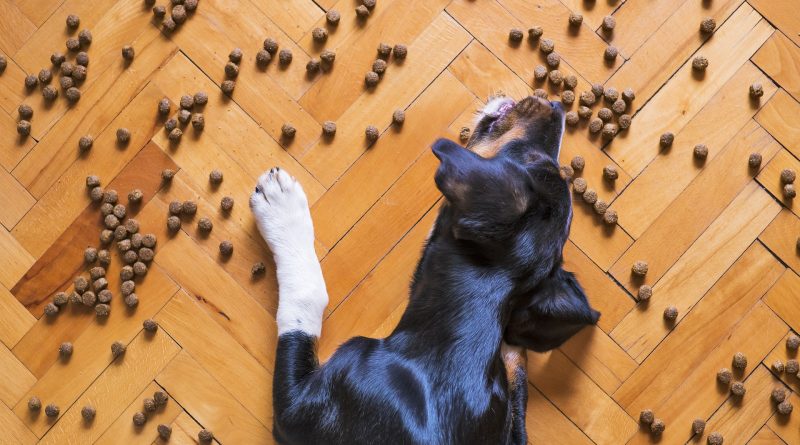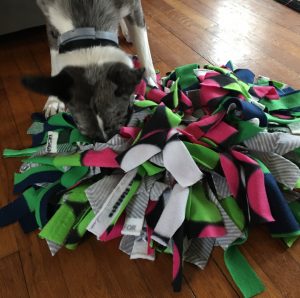Putting the brakes on a chowhound
Some pets get very excited about mealtime. So excited that they gobble up all their food within seconds of it being put into their bowls. When I got my dog, a 13-month-old Labrador, this summer, her previous owner warned me that she *really* liked her meals. That this was no exaggeration became very clear after I fed her a few times.
Here she is eating her meal:
Nineteen seconds! She ate about 500 calories (half her daily calorie needs) in 19 seconds! Even worse, the particular diet that she was fed was designed with big kibble to try to slow down eating – so this might have been slower than it would have been with smaller kibble (or a bowl that didn’t slide around on the floor)! I realized immediately that I needed to find ways to slow her down.
Risk of eating too fast
Pets that eat too fast can put their health at risk. Fast eating can increase the risk of choking and can increase the amount of air that is ingested, which can cause burping or flatulence. Gobbling food can also lead to vomiting and may be a risk factor for gastric dilatation and volvulus (GDV) in dogs. GDV is a life-threatening condition where the stomach expands and then twists onto itself, reducing blood flow to the stomach and back to the heart. Without rapid stabilization and surgical correction, this condition is typically fatal.
Pets that eat very quickly are also at higher risk of becoming overweight if their food intake is not closely measured as they will consume huge amounts of calories before the signal can make it from their stomachs to their brains to tell them that they are full.
Slowing down eager eaters
Thankfully, this issue is common enough that many products and techniques are available to slow pets down at mealtimes. Here are a few options to try (note that there are many different options and we are not endorsing any specific products):
- “Slow feed” bowls – these are special bowls that have raised areas that make it harder for the pet to get the food out. There are various options available from simpler to more complex and in many sizes, so there is likely an option that will fit for nearly every pet and household. There are versions available for both dogs and cats and can be used with dry or canned food. Some have rubber bottoms so that they stay put, while others are designed to slide around the floor to make things harder for the pet.
Here’s my dog with a slow feeding bowl:
It took her over 3 minutes to eat the same amount of the same kibble this time! A definite improvement!
- Food dispensing toys – these are typically made for dry diets and are available for both dogs and cats. Some are batted about by the pet and then food falls out of a small hole. Others are more like puzzles – the pet has to push a lever or pull out a drawer to access the food. These products can be used to feed whole meals, although some may not hold enough food for a full meal without refilling.
Here’s my dog using a puzzle toy:
- “Snuffle mats” – these are alternatives to bowls and food dispensing toys. They are made of fabric strips and dry food is hidden within the strips and the pet has to sniff around and move the strips to find the food. They can be purchased already made or made at home as a fun craft project!
- Hand-feeding – although this strategy is less common, it can be really useful, especially for dogs in training or single cat households. There is no reason why your pet has to eat from a bowl. I take a portion of my dog’s kibble in a treat pouch when we go for walks and use it to reinforce good behavior – walking quietly beside me on a loose leash, ignoring poorly behaving dogs that pass us, etc. I also use it for trick training, which we do daily. When the food is provided a few kibbles at a time, she can’t wolf it all down in seconds! Individual kibbles can also be tossed for the pet to chase – this can be particularly useful for otherwise lazy cats.
Here’s my dog demonstrating one of her favorite tricks:
Try out these different options and see what works best for you and your pet. Different options can be purchased from your favorite local or online retailers or even made at home! You might find that a combination of these approaches works best for your pet and your lifestyle.
For more suggestions for cats, check out this previous post.
We do recommend that pets always be closely supervised when using feeding toys, to ensure that they do not destroy the toy or try to eat pieces of it.


